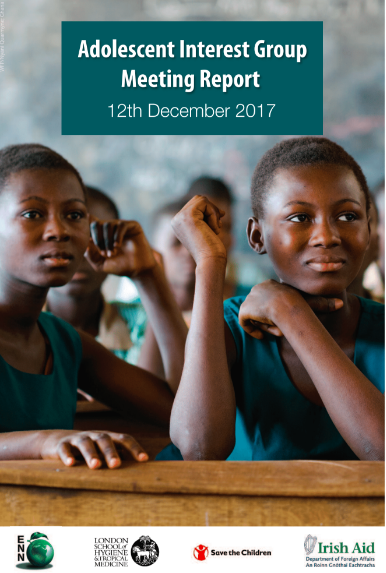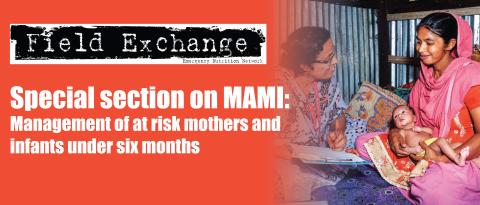Adolescent Nutrition Interest Group meeting
 A one-day meeting of the Adolescent Nutrition Interest Group (ANIG) was held in London on 12 December 2017. The meeting was co-hosted by Emergency Nutrition Network (ENN), London School of Hygiene & Tropical Medicine (LSHTM) and Save the Children, with funding from Irish Aid (via ENN). A background paper was prepared by ENN for the meeting, synthesising the evidence to date for adolescent nutrition, key gaps and opportunities (www.ennonline.net/adolescentmeetingsynthesis). The meeting aimed to build on the upsurge of attention currently surrounding adolescents and establish an interest group with the following aims: identify emerging research and operational experiences; disseminate existing data with potential for analysis from an adolescent nutrition perspective; help ‘bridge’ the disciplines of health and nutrition by facilitating discussion and learning; and facilitate potential future collaborations, including funding opportunities.
A one-day meeting of the Adolescent Nutrition Interest Group (ANIG) was held in London on 12 December 2017. The meeting was co-hosted by Emergency Nutrition Network (ENN), London School of Hygiene & Tropical Medicine (LSHTM) and Save the Children, with funding from Irish Aid (via ENN). A background paper was prepared by ENN for the meeting, synthesising the evidence to date for adolescent nutrition, key gaps and opportunities (www.ennonline.net/adolescentmeetingsynthesis). The meeting aimed to build on the upsurge of attention currently surrounding adolescents and establish an interest group with the following aims: identify emerging research and operational experiences; disseminate existing data with potential for analysis from an adolescent nutrition perspective; help ‘bridge’ the disciplines of health and nutrition by facilitating discussion and learning; and facilitate potential future collaborations, including funding opportunities.
Interested operational agencies, United Nations staff, researchers and academics were invited to join programmers at the meeting. There were 29 participants in total, including two remotely. Presentations and discussions were focused around three interconnected themes: populations, interventions and outcomes. Twelve presentations were given in the morning covering a range of topics. In the afternoon a prioritisation exercise was conducted to identify top research and operational priorities in this area. Headlines are summarised below.
Adolescents are defined by the World Health Organization (WHO) as the population between the ages of 10 and 19 years. However, this definition masks a diverse group, whose needs vary according to age, gender and urban/rural context, requiring a range of tailored interventions and approaches and measurement by specific outcomes, both structural and functional. Categorisation by age may be meaningless in many contexts where adolescents are more commonly defined by social standing and/or grade in school. It is critical to target boys and girls, although in view of the seriousness and far-reaching nature of the consequences, preventing early marriage and delaying pregnancy in younger girls must be considered the top priority.
Adolescent girls remain nutritionally vulnerable, suffering from persistently high rates of underweight, increasing prevalence of overweight and obesity, and micronutrient deficiencies (particularly anaemia). During the meeting, the World Food Programme (WFP) highlighted the fact that an adolescent girls’ diet is the most costly (or is on a par with that of a lactating woman) in every country and this cost increases even more with pregnancy. This reflects the high nutritional requirements of adolescent girls and the fact that the necessary nutrients are usually only found in relatively expensive foods. Another reason to focus on this group is that there is compelling evidence to believe it is worth the investment, both for this generation and, through adolescents’ role as future parents, for generations to come. Adolescence also provides a possible window for catch-up growth; research indicates that this also has repercussions for the next generation. There are currently many gaps in our knowledge and it is critical that we start to fill them to address adolescents’ needs more effectively.
Several important issues were raised for consideration during discussions on what we want to achieve when working with adolescents. While physical outcomes are important, it does not matter per se whether the individual is short or tall. What matters are the associated risks: height and body mass index are important predictors of risk of birth obstruction and non-communicable diseases. It is also important to take a lifecycle approach; inter-generational cycles are not solely about biology, and adolescence provides great opportunities to reset norms. Cognitive outcomes are critical, but we need to improve tools to measure these effectively. More discussion is needed on the cost-effectiveness of addressing the nutritional needs of this age group (in comparison with investments for the first 1,000 days). It is important to remember that there can be considerable risks with interventions in this age group. Improving nutrition in younger adolescent girls can lead to early puberty, potentially leading to earlier age at first pregnancy, with associated risks, and shorter and more overweight individuals. Randomised controlled trials are needed to understand this better.
During discussions, three platforms were identified for interventions in this age group, as well as associated challenges, as follows:
Health – Adolescents have many competing priorities, particularly older adolescents aged 15 to 19 years; health is often seen as a long-term issue which can be put to one side for the time being and public health messaging may not be a primary source of information for adolescents.
Schools – Landscape-mapping in Bangladesh found schools to be the most promising platform to reach adolescents, while working with adolescents as agents of change and using participatory methods also show great promise.
Peer-to-peer work – The influence of peer opinion, particularly among older adolescents, is very important to consider in adolescent programming and research.
Reaching adolescents through other sector platforms (e.g. through sexual reproductive health and avoiding early marriage) and other nutrition-sensitive programmes may provide the most effective channels for improving adolescent nutrition. There is a need to consider social aspects when intervening, engaging with young people’s experiences and the vital role of the education system in changing household behaviour. It is critical for the nutrition community to learn from others who have already pioneered work on how to engage with adolescents successfully, such as in education and HIV prevention.
For each of the three themes (populations, interventions and outcomes), operational and research priorities were discussed and identified by participants, with a voting system to choose the most important. The overall research priority identified was how to engage adolescents effectively. The overall operational priority identified was using age at first pregnancy as an outcome of interventions. The group felt that these priorities need to be considered alongside those coming from the SPRING/USAID /PAHO consultation held in October 2017, summarised in the presentation by the SPRING representative.
At the end of the meeting, discussions were held regarding future plans. The organisers expressed hope that this is the start of a group which will work together to address many of the issues discussed at the meeting. Regular calls (once every four months) were proposed to move forward recommendations, to which all participants were welcomed. ENN will initiate this and write a terms of reference for the group. Other ways forward proposed included:
- Creation of an adolescent thematic area on ENN’s online forum, en-net. Two or three expert moderators will need to be recruited for this. (This has been launched; see: www.en-net.org)
- Potential creation of a ‘closed discussion group’ through ENN’s new initiative; Nutrition Groups (www.nutritiongroups.org/)
- Investigate the potential for a nutrition group within the Lancet Commission on Adolescent Health.
- Reach out to and link the various initiatives gathering momentum on adolescents (such as this group, SPRING, WHO and Lancet).
- Organise a gathering every year or two in a similar vein to the Management of at risk Mothers and Infants (MAMI) Special Interest Group (www.ennonline.net/ourwork/research/mami).
- Think about how to address the reasons why adolescent nutrition has been neglected and why little has moved forward to date, including: Who has responsibility for this age group? Who is championing their needs? What is the hierarchy of needs and where to start?
The full meeting report can be downloaded here.
For more information please contact Emily Mates.


